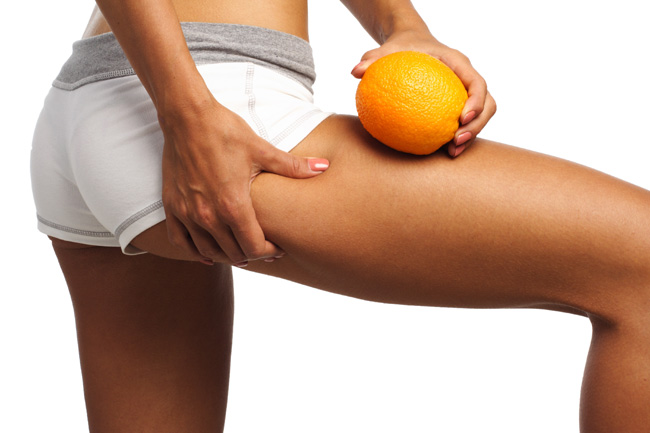Cellulite is an unofficial, non-medical term for fat tissue that deposits below the top skin layers called subcutaneous tissue. This fat tissue then becomes engorged into cells and which then “pulls down” on overlying skin. This tugging creates an indentation of the skin over the thighs and buttocks area. The physical appearance of Cellulite is as the skin of an orange in medical terms known as peau d’ orange or “dimples”. The term “cellulite” was first used by Alquin and Pavot in France in 1920 when their observations led them to associate this un-aesthetic condition with a possible pathology.

Cellulite is certainly not a serious condition but does represent the most widespread and least tolerated aesthetic complaints among women. It has gained much publicity campaigns in the mass media and the cosmetics industry targeted at increasing the market for cosmetic creams, pills, and other fake medical fantasies that often lack a scientific basis though they sometimes improve the aesthetic aspect of the problem.
When does cellulite become evident?
Cellulite nearly always starts during puberty, affecting particularly the legs. It may also be noted after the following states:
·Pregnancy
·Periods of sexual dissatisfaction
·Lack of human or family understanding in combination with an altered lifestyle, wrong diet
·Intestinal dysfunctions.
An estimated 85% of women over the age of 20 have some degree of cellulite. It is important to note the cellulite and obesity may coexist, but they are definitely different.
When fatty tissues exceed the normal value of 30%, there is obesity, but cellulite only involves a transformation and alteration of subcutaneous tissues and is certainly not a mere accumulation of fat. So please don’t rash to those weigh loss clinics in hope of curing the cellulite phenomenon. These factors lead to the following manifestations among women:
·Altered skin sensitivity
·Pain and cramps
·Heaviness
·Tiredness
·Night restlessness
·Cold feet
·Dry skin
·Swelling of skin
·Changes in skin colour
Who is at risk?
·Ethnic origin. White women are at higher risk than black women. A family history of genetic endocrine–metabolic syndromes and nutritional deficiencies increases the risk.
·Patients suffering from frequent hormone imbalances and those who consume progestagen or hormone-supplemented foods. The intake of estro-progestagens such as those included in birth-control pills and food preservatives favours cellulite.
·Those with alteration of posture leading to deposits of fat at abnormal sites.
·Taking excess of sugar and fats.
·Disorders of depression, anxiety or languid, apathetic, and faltering character are also frequently associated with cellulite.
·Some allude to the fact that sexual activity is one of the basic activities of life, as essential as feeding oneself and breathing. Satisfaction from it should always exist so that the remaining normal metabolic functions work properly. Sex has a “physiological” manifestation with the urge to elicit “organic functions and reactions”. This should be fulfilled, because it is a chemical catalyst of many other functions.
·Poor lifestyle with improper balance in diet, gut evacuation, work, sleep, and exercise.
·Tight dresses, jeans, and unnecessary elastic hoses. These types of clothing is shown to favour cellulite pathologies of the metabolic hypoxic (low tissue oxygen) type.
·Smoking has been shown to slow down blood flow to the skin arteries and increase fat to the skin leading to peau d’orange.
Treating the cellulite
It is important to note that cellulite is a condition that develops over years and will take several months before any effect may come apparent. You will need to get several tests to determine the type of cellulite and mode of treatment. Such tests include; blood sugar, tests for oxygen radicals, cholesterol, among others.
1.The massage: Vigorous massage to the skin encourages removal of excess fluid and improves drainage. Initially the skin improvements are short term and just related to the removal of excess fluid, but an advanced system called the LPG massage gives long term treatment. Louis Paul Guitay ( LPG) endermologie is an FDA approved machine-assisted massage system that allows positive pressure rolling in conjunction with applied negative pressure to the skin which improves body contour and skin texture.
2.Skin creams :
·Agents that increase blood flow. Ivy, Indian chestnut, Ginkgo biloba, Red grapes, Papaya and Pineapple.
·Agents that reduce fat deposit and promote fat breakdown; Caffeine, aminophylline &theophylline (also used to treat asthma), adrenaline, and yohimbine.
·Agents that restore the normal structure of skin; vitamin A & C creams
·Agents that prevent free-radical formation; Vitamin E, C, Gingko and red grapes creams.
It is important to note that there are other forms of therapy such as liposuction, TriAction (containing contact coolant, massage, and diode lasers), carboxytherapy (carbon dioxide use) and surgery.

